Joseph Haydn was appointed vice-Kapellmeister at Esterhazy by Prince Paul Esterhazy in 1761 which began a thirty year association which Barrett-Ayres (1974, p.246) describes as, a relationship between master and man which is quite unique in the history of music; a relationship which proved beneficial to both parties and left the world a richer legacy of good music.
At the time of his appointment the transition from the baroque era through the transitional forms of the Pre-Classical period to the newly emerging classical style was gathering momentum. The development of sonata form, which was to become the principal factor in the ascendancy of instrume ntal music during the late eighteenth and nineteenth centuries, was in its infancy (Grove, Vol. 17, p. 500). This essay will begin by firstly discussing briefly the origins of both the string quartet and sonata form; secondly, their stage of development upon Haydn's appointment at Esterhazy; and finally, it will focus on the string quartets of Joseph Haydn, composed during his long employment at Esterhazy, and discuss their contribution to the string quartet genre and the development of sonata form.
From the point of view of structure there can be no doubt that the two-part binary form, which existed in the dances of the early suite, became the basis for the sonata form of the eighteenth century. Colles (1959, p.63) suggests that sonata form began to take shape in the harpsichord sonatas of C.P.E. Bach. Example 1 shows the tonal plan of a typical baroque binary movement compared to a movement from a C.P.E. Bach Harpsichord sonata written around 1744. The new sonata principal differs from the baroque style in two main areas: firstly, a typical baroque movement is based on one single main idea and is governed by a single texture, whereas a movement written in the new Classical style would normally consist of several contrasting ideas which are developed dramatically to provide tension and resolution; secondly, the Baroque movement would normally feature a linear bass line following a metrically orientated rhythm, reinforced by the continuo, whilst the Classical movement would dispense with the continuo and the bass would play a more harmonic role (Grove, Vol. 17, p.498).
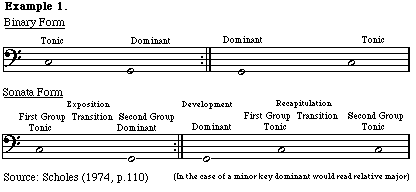
Tovey (1963, p.521) emphasizes the importance of basing an analysis of a sonata form movement on tonal centres as opposed to themes, "if the practice of Haydn, Mozart, and Beethoven be taken as a guide the discoverable rules of sonata form are definite as to the distribution of keys, and utterly indefinite as to the number and distribution of themes in these keys". This premiss which is also expounded by Green (1979, p.218) will be used throughout this essay.
A typical sonata-form movement, as in example 1, consists of a two part tonal structure divided into three main sections. The first part of the structure is called the 'exposition'. The second part of the structure comprises the remaining two sections, the 'development' and the 'recapitulation' (Grove, Vol. 17, p.497). The exposition may be conveniently broken up into four further sections: firstly, the Primary key section which expresses thematic material in the tonic key, which is then followed by a second section which takes the form of a transitional passage, its function is to deflect the listeners attention away from the tonic key and prepare the arrival of the third section, w hich is called the Secondary key section. In the initial stages of sonata form evolvement many development sections began with a simple restatement of the main theme in the dominant. This section comprises of material presented in a related key, usually the dominant in the case of a major key, or the relative major in the case of a minor key. Finally, the exposition is usually rounded off with a closing cadential section which reaffirms the new key. The development section is used by the composer to introduce tension into the work by expanding on the material presented in the exposition, usually in a number of related key centres. In the initial stages of sonata form evolvement many development sections began with a simple restatement of the main theme in the dominant (Kohs, 1976, p.262). The purpose of the final section, the recapitulation, is to unify the entire movement by firmly restating all thematic material presented in the exposition in the tonic tonal centre.
The origins of the string quartet may be traced to four sources: firstly, the four-part sections called sonata a quattro from the early eighteenth century Italian sinfonia; secondly, the French sonate en quatuor and ouverture a quatre; thirdly, the pre-Classical forms such as the divertimento, cassation, notturno and the serenade; and finally, the quartet-symphonies of the Mannheim school from around 1745. These works were usually written in an orchestral style which featured the predominant melodic interest in the first violin part and frequent doubling between the viola and the bass (Grove, Vol. 18 pp.277- 278). It is not until Haydn's Opus 9 quartets of 1769 that Goethe's definition of the string quartet as "a stimulating conv ersation between four intelligent people" (Barrett- Ayres 1974, p.7) becomes applicable. Haydn considered that his true quartet output began with the six quartets of Opus 9. Because of this statement, plus the controversy that surrounds the authenticity of Opus 3, and also the fact that some of the first 18 quartets were written originally for various instrumental combination and were published, apparently without Haydn's authorisation, at a later date as quartets arrangements (Olleson, 1974, p.9), this essay will begin by examining Opus 9 which coincides with Haydn's first years at Esterhazy.
With Haydn's Opus 9 quartets (1769) all semblance to the orchestral style is absent (Tovey, p.532). The overall structure takes on the standard four movement scheme featuring two allegro outer movements enclosing a minuet and a slow movement. The first movement is usually in sonata form and much more emphasis is given to the development section of these movements which now sometimes equal the length of the exposition (The New Oxford History of Music, p.553). An interesting example, whilst not typical of the entire series but appearing to point to Haydn's historic Sun Quartets Opus 20, occurs in Opus 9 No. 4 in D minor (Ex. 2). Haydn becomes more adventurous with the lower strings which share the thematic material. At bar 1 the viola shares the theme with the first violin, whilst bars 3 and 4 feature a dialog between first violin an d lower strings (Olleson, 1974, p.15).
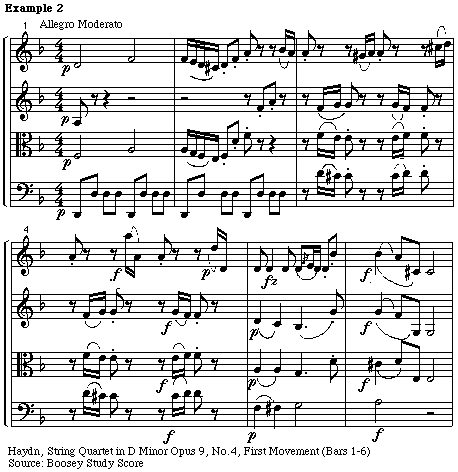
Haydn's Opus 17 quartets were published in 1771. No. 4 in C minor features a number of interesting developments. An examination of Score example 1 indicates that the opening movement is monothematic. All thematic material for the entire movement originates in the first eight bars, a technique that will become increasingly more common in Haydn's later works. The secondary key section at bar 20 is in the key of Eb major. Here Haydn employs "one of his favorite formal devices: instead of a new theme at this point we find a variant of the first theme" transposed to the new key (Olleson, 1974, p.18).
It is also apparent that Haydn has shortened the recapitulation by 24 bars. Bars 9 to 19 of the transition have been omitted, because their role of providing modulation to the second subject is redundant in a monothematic movement, and Bars 20 to 32 which contain secondary key group material are no longer needed, as the second group material is derived from the first, therefore a recapitulation in the tonic is a mere repeat of theme one. Extensive reworking of exposition material when it is restated in the recapitulation is very characteristic of Haydn, particularly in a monothematic movement such as this one. "Haydn seems anxious not to over-work his one subject, as might happen if the recapitulation exactly followed the lines of the exposition" (Olleson, 1974, p.19). As if to compensate for the shortened recapitulation, Haydn adds, for the first time, a coda (bar 120) constructed from the rising third motif from the primary key section and the two bar closing phrase which roun ds of the exposition and the recapitulation. Harmonically the movement is also very interesting; a glance at the movement tonal plan (Ex. 3) will reveal Haydn's rather adventurous journey through a number of key centres in the development section which begins at bar 54 in the submediant key of Ab major. Bar 79 features the opening motive in first species counterpoint, which is then followed at bar 86 by a false recapitulation. Both these features became important characteristics of Haydn's future writing.
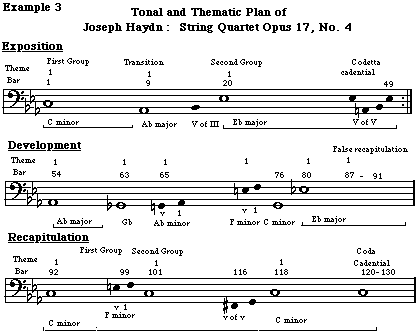
Tovey (1963, p.538) sums up the importance of Haydn's next set of six quartets, Opus 20 written in 1772, as follows: "with opus 20 the historical development of Haydn's quartets reaches its goal; and further progress is not progress in any historical sense, but simply the difference between one masterpiece and the next"
Mozart also recognised the importance of this set and was inspired to write a set of six quartets K.168-K.173 using Haydn's as a model. Later it will be seen that Haydn was influenced in turn by the younger Mozart (Crocker, 1966, p.393).
Kirkendale (1979, p. 141), commenting on the more serious nature of these quartets, suggests that Haydn may have been reacting against the accusations of 'trifling' which had been directed at his earlier quartets. Haydn's imagination has now awakened to the tone of the cello as something more than a mere amenable bass to the harmony. For example three of the quartets in this series feature a fugal final movement (The New Oxford History of Music, p.555). But it is not only in the fugues that the richer counter -point and more serious manner are apparent, as now for the first time fugal writing appears as a normal resource in the movements of sonata form (Tovey 1963, p.536; Edwards 1991, p.230).
Opus 20 No.2 in C major provides a good illustration of Haydn's more serious tone and greater expressive range. The first movement commences in triple counterpoint and "Haydn's imagination has now awakened to the tone of the cello as something more than a mere amenable bass to the harmony" (Tovey, p.533), as the first statement of the theme is given to the cello and second violin, whilst the viola is assigned the role of the bass. (Score Example 2, opening bars) Bars 2 and 3 are interesting as they feature the cello placed above the second violin. As the movement progresses the fugal opening ope ¿ns out into a more harmonic style (bar 23) which Barrett-Ayres (1974, p.134) sums up in saying "By causing a dualism of style, he adds a new dimension." Example 4 also highlights Haydn's imaginative use of harmonic progressions, in particular the way in which he approaches the cadence at the end of the secondary key section (bars 37 to 44) through the tonal centres of G minor, Eb major, and then to the dominant via a augmented sixth chord. The development which commences at bar 48 in the dominant minor (Ex.4), a technique which Haydn continues to utilise frequently throughout his career, features a running dialog between cello and first violin (bars 48-60) which modulates through a series of related keys (Ratner, 1980, p.117).
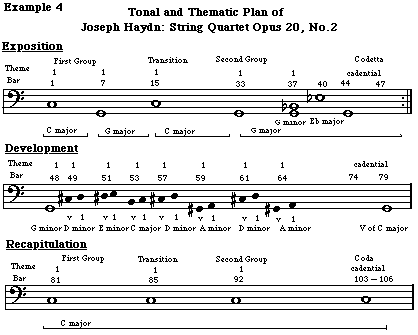
Nine years separate the quartets of Opus 20 from Haydn's Opus 33, the set of six written in 1781, usually referred to as the "Russian Quartets". Haydn describes this series in a letter to the influential Swiss gen tleman J.C.Lavater as being written "in a new and special way" (Barrett-Ayres, 1974, p.153). With the exception of the first quartet Sonata form is used only in the first movements; the final movements see a return to the lighter forms such as the rondo or theme and variations (Barrett-Ayres 1974, p.155-156). Overall the quartets appear somewhat lighter in style, which Olleson (1974, p.26) suggests is due mainly to the distribution of important thematic material through all parts (Score example 3, bars 65-71). The more independent nature, plus the assignment of more thematic importance to the lower strings evident in Opus 20, is now all but "taken for granted as the natural musical language" (Olleson, 1974, p.26). The development section from Opus 33 No.5 in G major (Score example 3) demonstrates the principal of thematic elaboration that Haydn now systematically employs. In this movement Haydn uses four distinctive thematic elements upon which he constructs the entire sonata form movement. This movement is also interesting harmonically: firstly, Haydn steps straight from the dominant seventh chord to the flattened submediant chord to commence his coda at bar 272, this technique will become common place in Haydn's later works (Rosen 1971, p. 313); secondly, Haydn commences the development section by restating his primary group theme in the tonic minor before making an exhaustive exploration of numerous key centres (Ex. 5).
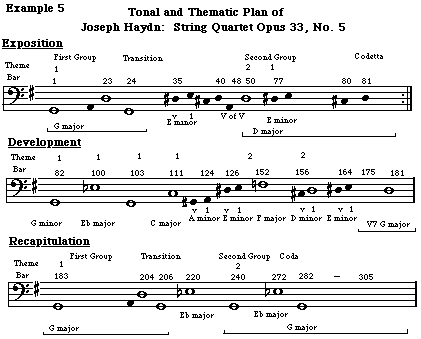
Haydn dedicated his Opus 50 of 1787 to King Friedrich Wilhelm II of Prussia who was a keen cellist, the florid nature of the cello part in these works may be attributed to this fact (Barrett Ayres, p. 247). With this set Haydn returns to a "more substantial tone, eloquent and profound rather than violent" (Crocker 1966, p.393) and develops even further his preoccupation with thematic elaboration and the preference for a "monothematic structure" (The New Oxford History of Music, p.554). "Monothematicism illustrates fully the importance of key centres in eighteenth century sonata form, for if there is but one theme, an antithesis between first and second group can only be achieved by contrasting tonal centres."(Barrett-Ayres, 1974, p.202).
Barrett-Ayres (1974, p.202) suggests that a theme contai ns a number of motives or ideas, which in a monothematic movement may be transformed and developed in numerous ways, thereby creating a theme which may be completely different from the original. "The first movement of the quartet in Bb Opus 50, No.1 (Ex. 7) is built from almost nothing at all: a repeated note in the cello and a six-note figure in the violin. Everything in the exposition is restricted to these two small elements" (Rosen, 1971, p.120). Sutcliffe (1992, p.67) makes two important comments on this movement: firstly, he draws attention to the parallels between the opening of this movement and the opening movement of Beethoven's first quartet Opus 18, No.1 (Ex. 6) which "testifies to the impact that Haydn's movement must have had on him"; and secondly, he states that Opus 50, No.1 shows the reciprocal influence that the younger Mozart had on Haydn. He points out that this quartet exhibits "an entirely new system of tempo" where he "halves the old eight-eight pace into barred C". Previously, Haydn would have defined the pulse as subdivisions of four in the bar, whereas he now feels the pulse in either whole or half bar units.
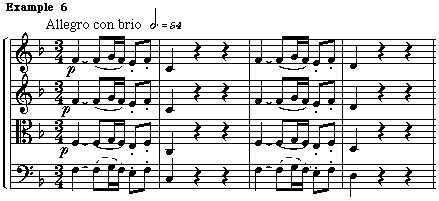
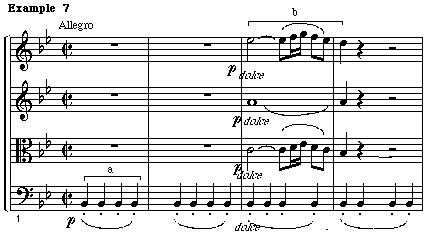
The six 'Tost Quartets' of 1788, published as Opus 54 and 55, were written for the celebrated violin virtuoso Johann Tost. Described by Barrett-Ayres (1974, p. 230) as a "continuation of the total experiment", they are, whilst not displaying any new developments, examples of Haydn's art at the peak of perfection. Haydn now writes monothematic sonata form movements more frequently, false recapitulations occur, and fugato passages during the development section are common. (The New Oxford History of Music, p.562). The year 1790, with the death of Prince Nicolaus Esterhazy, marks the end of Haydn's association with the house of Esterhazy. It also produced the six string quartets, Opus 64, representing the culmination of 30 years of development in which Haydn's contribution to the string quartet genre and the development of sonata form was substantial. Opus 64 No.5, commonly called The Lark, is possibly the most popular among Haydn's entire quartet output (Keller 1986, p.164), and exhibits many of these developments. The first theme of the opening movement (Score example 4) beginning in staccato quavers at bar 1 then transforms into a subordinate accompaniment on the entry of the soaring 'Lark' theme at bar 9. The transition, entering at bar 21, contrasts the lyrical 'Lark' theme by adding an element of chromaticism before the arrival at bar 36 of the syncopated first theme in the second key area. A descending triplet passage,followed by an ascending chromatic passage at bar 50, makes up the second theme before a four bar codetta commencing at bar 56 rounds out the exposition. The development, commencing at bar 60 in G major (Ex. 8), begins with material from the first key group. Bars 60-72 are derived from the first and second themes from this group, then at bar 73 Haydn introduces a descending triplet motif in the viola and cello, taken from theme 2 from his second group, before returning momentarily to the "Lark" theme at bar 85. The syncopation at bar 89, derived from theme 1 of the second group, opens out into a driving closing passage constructed from the descending triplets of group 2, and the staccato opening passage of group one. The recapitulation, commencing at bar 105, is typical of Haydn's dual thematic movements except that at bar 142 he restates the 'Lark' theme before bringing back the syncopated theme from group two. Barrett-Ayres (1974, p.260-261) draws attention to two important elements present in this movement: firstly, the "juxtaposition of diatonic and chromatic melody" which exists between the diatonic simplicity of the 'Lark' theme (bars 9-21) and the tense chromaticism of the transition and the first of the second group themes (bars 22-49); secondly, the greater use of the German sixth chord which occur at bars 48, 87, 137, and 167.
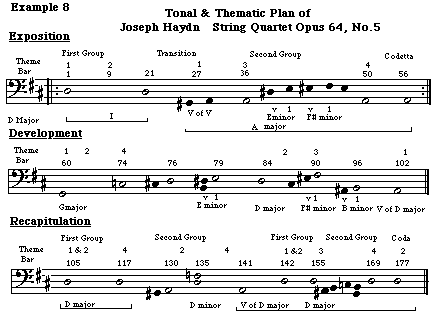
During Haydn's years at Esterhazy his concept of musical art, that of conflict and resolution firmly based within the tonal system and of economy of material applied with clarity and balance, was formed. These concepts are most noticeable in the 43 quartets (the 7 quartet arrangements of the "Seven Last Words' have been omitted) composed during this period; for in the string quartet Haydn appears to have found the ideal vehicle through which to express his conceptions. His contributions to the development of sonata form, which include motivic development, introduction of the coda, thematic transformation, equality of part writing, the reconciliation of both contrapuntal and homophonic textures, the growth in importance of both the second theme group and the development section, and the expansion of harmonic resource through the contrast of tonal centres, were to have a profou nd influence on all who were to follow.
By Bill Tyers ©2000 All rights reserved.
Barrett-Ayres, Reginald, 1974, Joseph Haydn and the String Quartet, Barrie & Jenkins, London.
Beethoven, Ludwig, Complete String Quartets, Dover Publications Inc., New York
Colles, H., C., 1959, The Growth of Music, Third Ed., Revised Bloom, Oxford University Press, London.
Crocker, Richard, 1966, A History of Musical Style, Dover Pub. Inc., New York.
Edwards, George, 1991, "The Nonsense of an Ending: Closure in Haydn's String Quartets", The Musical Quarterly, Vol. 75, No. 3.
Green, Douglass M., 1979, Form in Tonal Music, Holt, Rinehart and Winston Inc., Fort Worth.
Keller, Hans, 1986, The Great Haydn Quartets: Their Interpretation, J.M. Dent & Sons Ltd., London.
Kirby,F.,E., 1979, Music in the Classic Period, Schirmer Books, New York.
Kirkendale, Warren, 1979, Fugue and Fugato in Rococo and Classical Chamber Music, Duke University Press, Durham.
Kohs, Ellis, B., 1976, Musical Form, Houghton Mifflin Company, Boston.
New Grove Dictionary of Music and Musicians Ò, 1980, Ed. Sadie, S., Vol. 18, Macmillan, England.
Oleson, Philip, 1974, The Rise of the String Quartet, The Open University Press, Walton Hall, Milton Keynes.
Rosen, Charles, 1971, The Classical Style, Faber and Faber, London.
Ratner, Leonard, 1980, Classic Music, Schirmer Books, New York.
Scholes, Percy, 1923, The Listener's History of Music, Oxford University Press, London.
Sutcliffe, W., 1992, Haydn: String Quartets, Op.50, Cambridge University Press, Cambridge.
The New Oxford History of Music, Vol. VII, 1973, Ed. Egon Wellesz & Frederich Sternfeld, Oxford University Press, London.
Tovey, Donald, 1963, in Cobbett's Cyclopedic Survey of Chamber Music, ed.
SHARE THIS PAGE!